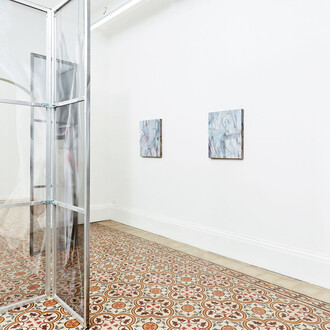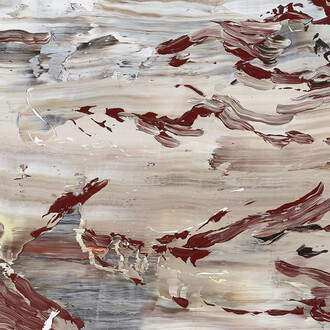The fusion between contemporary artistic practices and shamanism in the exhibition Al lupo, al lupo represents an interesting example of how cultural tradition, the study of nature and ancestral spirituality can meet contemporary artistic language to create new forms of expression. Artists such as the well-known Joseph Beuys, supported by the performative acts of the Fluxus group and followed, between the 1960s and 1970s, by the Italian Arte Povera artists, have been interested in shamanic practices or have drawn from them to investigate the hidden depths in the imagination of the surrounding reality.
The wolf, a key figure and guide within the initiatory path, an evocative symbol of the wild and mystery, merges with the practices of the seven artists present in the exhibition to accompany us on a stratified path that seeks to probe the depths of the unconscious and the irrational by posing reflective ideas inherent to nature, ecology, the body and phenomenology.
The reference to the figure of the wolf can therefore be interpreted in different ways: as a symbol of the wild and uncontrollable nature that hides within us, as a metaphor for the struggle between rationality and instinct, but also as a representation of otherness and diversity. Contrary to the stereotype that links the myth of the wolf to modern civilization, which from Aesop1 onwards made it an emblem of evil and ferocity, the figure that the wolf manifests stands within the exhibition design as a totemic animal, as it was in many ancient tribes and civilizations, a symbol of fertility, protection, courage, the founding myth of Rome but also a bearer of success and victory alongside the god.
The image of the wolf unhinged by the synonym of voracity and individualism that man projects onto himself. The sacredness that binds the shaman to an animal that has been able to survive extinction.
The wolf, as well as the artist, becomes, in a profoundly alienated and disturbing society like ours, a clearing of the human soul, a metaphor of light and truth, a guide for an initiatory journey to discover an intimate and secret identity. It becomes a figure balanced between “healer and cultural mediator” capable of introducing us through the change of his state of “artistic consciousness” in a different condition of awareness and reflection. Seven artists2, intent on inserting themselves into new horizons of thought in the nescience of habit and the atrophy of sensation, through the innate desire to connect different philosophical ideas give life to performative actions, therapeutic rituals and dreamlike images.
The works on display can mean a gesture of revolt, an attempted act of liberation from the media exploitation that emerges in the contemporary panorama.
Davide Dicorato places himself in the role of mediator between man and nature through associations, the search for balances and harmonies. The purpose of his artistic exploration is, as in the ancient practice of shamanism, to bring the spectator into deep contact with nature and the animals.
Nicola Ghirardelli analyzes, in sculptural terms, the possibilities inherent within a stratified fabric such as that of our Western culture, in which materiality operates on nature through fusion techniques typical of alchemical processes and where ancient knowledge resurfaces, recontextualizing unusual symbolic structures, giving new meaning to a story made of allegorical images and natural elements.
The point of view of the almost imperceptible movements of a disappearing lake in the black and white video by Marina Cavadini highlights the sensitivity and fragility of ecosystems, providing a representation of intrinsic resilience in some living beings present in increasingly hostile environments.
At the same time, Edoardo Manzoni places at the center of his investigation an analysis of the interaction between man and animal. Through games of seduction and predation, the theme of hunting, particularly dear to the artist for some time now, is linked to the magic that it hides within its own theater of forces. Through occult, mysterious and invisible arts, the “game” of one’s presence in the world is affirmed, in a continuous imbalance between oppression of something and defense from something.
Oliviero Fiorenzi also uses his own anthropological semiotic apparatus to reintroduce communication tools linked to play. However, distancing himself from Manzoni and Cavadini, the artist, born in Osimo, develops a symbolic alphabet that is closer to a typical practice of the infant, made of experimental prostheses and which operates as a device for contact with the natural elements themselves. The wind, an untamed and unpredictable element, a mystery that travels between the physical and the metaphysical, guides us, as does the figure of the wolf, beyond post-modernity in a becoming of acts of creation where it is the action that makes each exploration a unique and unrepeatable event.
For Edoardo Caimi, language has its roots in the primitive, the technological and the tribal, drawing on the cultures of suburban and rural outskirts, revealing itself through performative acts, sound archetypes, industrial and recycled materials, natural elements, in a narrative framework that imagines survival tools within a post-apocalyptic context.
Ludovica Anversa, through her painting, explores the thin line between figuration and abstraction, fusing hybrid theoretical and visual references. Recurring themes in her work include vulnerability and the relationship between perception and representation of the body. Floating in polymorphous and nebulous spaces that simultaneously evoke the interiors of bodies, bones, plants and insects, Anversa’s works resist determination, opening up a vast spectrum of shadows, impressions and enigmatic presences.
The figures in the paintings inhabit non-linear, anti-narrative spaces, where the body emerges as a permeable and receptive entity. Anversa investigates the precariousness of images, generating a sense of vulnerability that blurs the boundaries between perception and reality. An invitation, that of the artist, to reflect on the fragility of being and the continuous metamorphosis that passes through our existence.
(Text by Riccardo Angossini)
Notes
1 The fable Al lupo, al lupo, in English called Cry wolf, cry wolf!, attributed to Aesop, is among the most important of the
author; dated around the 6th century BC, it is also known as The shepherd’s joke.
2 Even the choice of a “group” made up of seven artists is not at all casual and tends towards the search for the “whole”. The
number seven, in fact, for different cultures and religions, expresses globality, universality, perfect balance and represents the
completed cycle of creation and of every form of knowledge.














